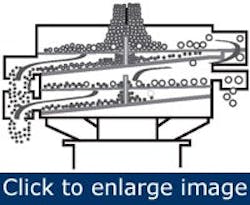Linen supply company boosts wastewater recycling capacity 67%
MacIntosh Services is one of the largest commercial linen rental supply companies in the scenic Lehigh Valley area of Northeastern Pennsylvania. The company supplies table linens and cloth napkins as well as uniforms, chef’s apparel, aprons and towels to restaurants, hotels and other facilities throughout Pennsylvania and New Jersey.
Every working day, the company uses more than 90,000 gallons of clean water to process this large volume of laundry and generates as much as 75,000 gallons of wastewater. “We try to recycle and reuse at least 40% of the wastewater we generate,” says Gary Shaffer, MacIntosh chief engineer.
A 48-inch-diameter Vibroscreen circular vibratory screener from Kason Corp., fitted with an 80-mesh screen, removes most of the larger solid waste particles before treating the wastewater using standard aeration and flocculation procedures. “The residue from the screener contains all sorts of solid waste, including not only lint, but also food particles, corks and even gloves,” says Shaffer.
Adding a second 80-mesh screen in bypass mode nearly doubled the flow rate through the 48-inch vibratory screener.
The screener separates bulk solid materials from solids and slurries using multi-plane, inertial vibration, allowing water and fine particles to pass through the screen while oversize particles travel to the periphery, where they are discharged. It features one imbalanced-weight gyratory motor mounted directly that operates continuously beneath the screening chamber.
Anti-blinding rings prevent fibrous, stringy and sticky materials from blinding the screen by vibrating continuously across a perforated stainless-steel plate, shearing fibers and scraping away gummy materials. The holes in the rings allow product flow over the entire screen surface, maximizing screening efficiency.
The screened water discharges into a 1,250-gallon storage tank and then is pumped through a four-pass heat reclaimer to preheat incoming city water before it travels on to the wastewater pretreatment system.
As the business grew, the volume of wastewater generated began to exceed the capacity of the 48-inch screener. “We really needed to go to a 60-inch unit, but the space we had available simply did not permit it,” says Shaffer. “Our solution was to add a Kason recycle screening deck on top of the existing screener, increasing its capacity from 100 gpm to 150 gallons to 225 gpm to 250 gpm without increasing its diameter. Retrofitting our existing screener also undercut the cost of purchasing a new 60-inch significantly.”
Positioned directly above the screening deck, the recycle deck has a screen of identical mesh. The upper screen deck is fed with more material than it can efficiently screen. Material passing through the upper screen deck is directed to the unit’s discharge outlet. The overflow, along with oversize solid particles, is directed from the upper screen onto the lower screen of the same mesh, where it is screened in normal fashion.
[pullquote]The effluent is treated in an on-site aeration and flocculation facility to remove solid waste and then reused at MacIntosh Services or returned to the City of Bethlehem to be further treated and added to the municipal water supply. The solid waste is removed in the form of sludge, which is dewatered and pressed into cakes. “We remove 300-450 tons of sludge per year. In fact, the water that we treat and return is sometimes even cleaner than the city water we use originally,” says Shaffer.
“Rapid changes in technology continue to affect every aspect of our business,” says Jim Rodgers, Jr., MacIntosh Services president. “We continue to invest our resources in new technologies that will help us streamline our operations, increase our efficiency and improve customer service.”

